The 12 Best Help Desk Software for 2023 - Buyer's Guide


Communication is at the center of most businesses.
Whether it’s communicating with customers to help resolve service-related issues or fielding IT requests from employees, most businesses eventually need some way to manage those conversations.
One of the best ways to do that is with help desk software.
Short on time? Choose Help Scout and get a free 15-day trial
If you don't have time to read this article but you want to know the right software to choose: it's Help Scout. Take a look at some of our product information below, or get started today with a free 15-day trial.
What is help desk software?
Help desk software is a tool used to organize, manage, and respond to service-related requests. Some help desks are used for external requests from customers, whereas others are used for internal service requests from team members.
Using a help desk platform is a great way to improve your customer experience — 75% of customers desire a consistent experience, regardless of how they engage a company (through social media, in person, by phone, etc.) — because it consolidates all of your customer support interactions into one omnichannel tool.
Help desks may include a variety of tools like a shared inbox, knowledge base software, and a live chat solution. However, not all help desks include all of the tools mentioned.
What is the difference between a help desk and a service desk?
The terms help desk and service desk are often used interchangeably, and given the overlap in functionality, it’s not surprising. Both tools:
Are used for communicating with customers and end users.
Use similar communication channels — email, phone, live chat, self-service, etc.
Provide ticketing or conversation systems for tracking issues with products or services.
Typically offer a knowledge management solution to promote self-service.
Integrate with other platforms in a company’s tech stack.
Provide reporting on things like ticket volume, request type, and team productivity.
However, help desks and service desks aren’t exactly the same. The real difference lies with their focus.
Help desks focus on reactive support — something goes wrong with a product or service, customers contact the help desk, and the team works to resolve the issue. This is sometimes referred to as incident management or a break-fix model.
Service desks provide some reactive support, but their main focus is proactive. Service management is about providing long-term solutions to emerging issues, preventing future incidents from taking place, and making strategic process changes to improve the organization’s level of service. They also may handle requests for new service or manage physical assets (computers, mobile devices, etc.)
Essentially, while both are concerned with product and service incidents, help desks center around the needs of the customer (or user) and service desks concentrate on the needs of the business.
The 12 best help desk software for 2023
In order to begin your search for the right tool, it helps to know at least some of your options. Below is a list of 12 of the best help desk software solutions on the market right now.
Help Scout
SysAid
Hiver
Freshdesk
Jira Service Management
Zendesk
Zoho Desk
Front
Gorgias
Kustomer
Spiceworks
Solarwinds Service Desk
1. Help Scout
Best help desk software for teams who prioritize customer satisfaction.
Help Scout is a complete customer support platform that includes every tool you need to deliver an outstanding customer experience. When you sign up for Help Scout, you get access to a number of tools.
Shared inboxes
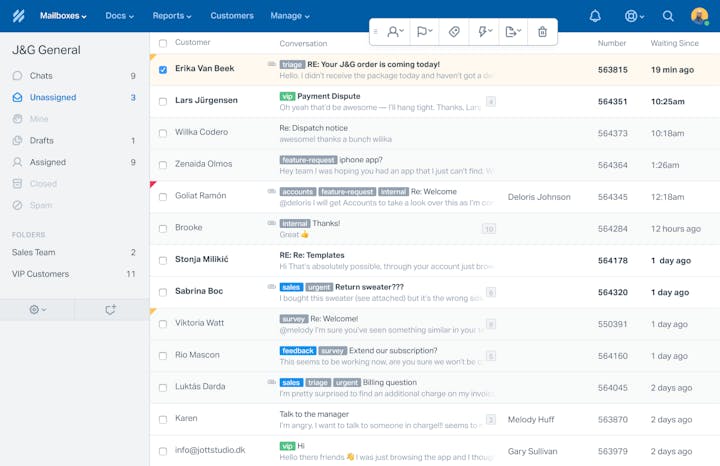
Help Scout's shared inboxes include collaboration tools like @mentions and private notes to ask others for help or to add more context to a customer conversation.
There’s also collision detection to reduce duplicate work, workflows to automate routing and routine tasks, and artificial intelligence (AI) features like AI summarize and AI assist to help make the support team's work a little easier.
Finally, saved replies make responding to routine customer queries a breeze.
Knowledge base
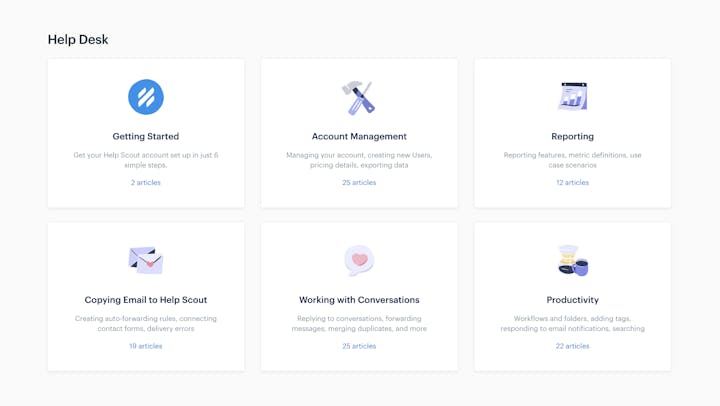
With Docs you’re able to create, manage, and organize self-service content.
The WYSIWYG editor makes content creation a breeze. You’re also able to upload videos, images, and other types of content directly to articles or embed videos to create even more robust self-service content.
Performance data helps you see which articles are performing best, which ones could be doing better, and what content you should create next.
Live chat
Help Scout's live chat widget, Beacon, is a multi-use tool that includes live chat as well as proactive support options through Messages.
The live chat function has online and offline options to help customers find the answers they need when and where they need them.
With Messages, you’re able to segment audiences based on specific customer attributes, schedule messages, and even see performance data to help further refine your efforts.
Reporting

Help Scout comes loaded with pre-built dashboards, so you’re able to see how your team’s performing right away. You can also create custom reports that focus on the metrics of your choosing.
If you want to do even more with your data, our API lets you export to the business intelligence tool of your choosing.
Customer profiles
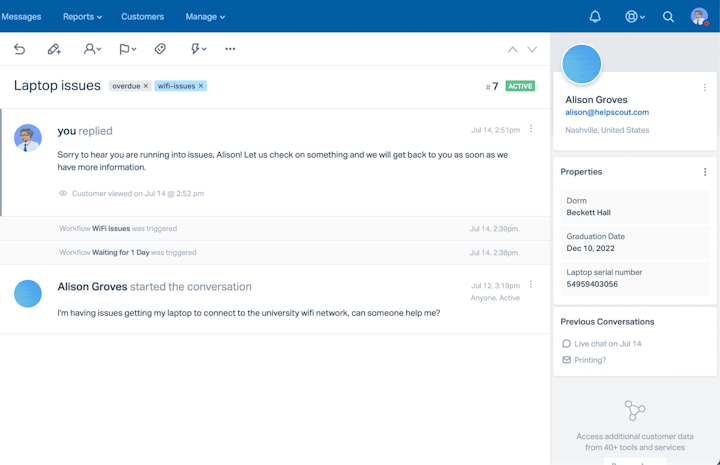
Customer profiles are automatically created for customers you’ve interacted with. They show basic information like their company, their role, and any previous interactions you’ve had.
You can edit and update customer profiles any time, ensuring all information is up to date and relevant. You can even automate the updating process by adding a few lines of code to any Beacon implementation.
Mobile apps
Finally, Help Scout offers mobile iOS and Android apps for teams who need notifications on the go or to resolve customer issues while they're away from their desktop machines.
Though Help Scout's features, which are all accessible via an intuitive, customizable interface, are impressive, we think our best asset is our world-class support team that is ready to help out 24/6. We also have an extensive knowledge base for those who prefer self-directed learning.
Price: Free trial available. Plans start at $20/user per month.
Learn more about Help Scout:
2. SysAid
Best help desk system for IT service management (ITSM).
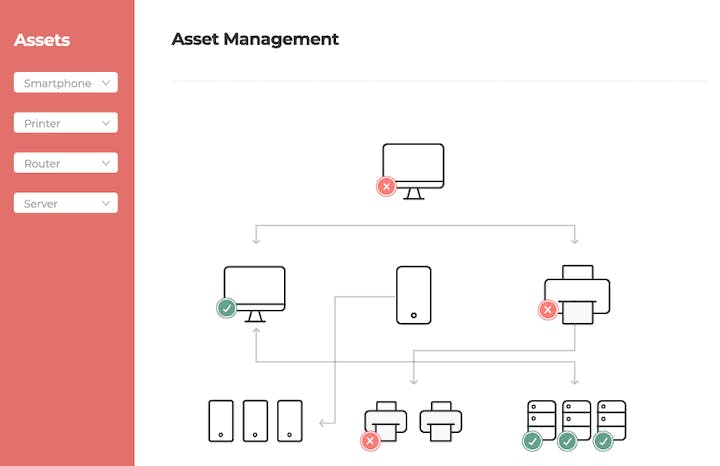
SysAid is a help desk ticketing system that manages internal IT requests. They offer a number of SLA management features like ticket and workflow automation to reduce SLAs. You can also build a self-service portal for knowledge management so employees can handle basic requests like password resets on their own.
You’re able to get things going quickly with a host of templates and default forms, or you can create your own custom ones to best serve the needs of your organization and your team. Since most IT tools are used in conjunction with one another, you also get access to a number of third-party integrations.
SysAid has powerful asset management features that make it easy to manage all of the assets in your network and see hardware and software for each of your end users.
Price: Free trial available. Contact SysAid directly for pricing.
3. Hiver
Best basic help desk for small businesses.
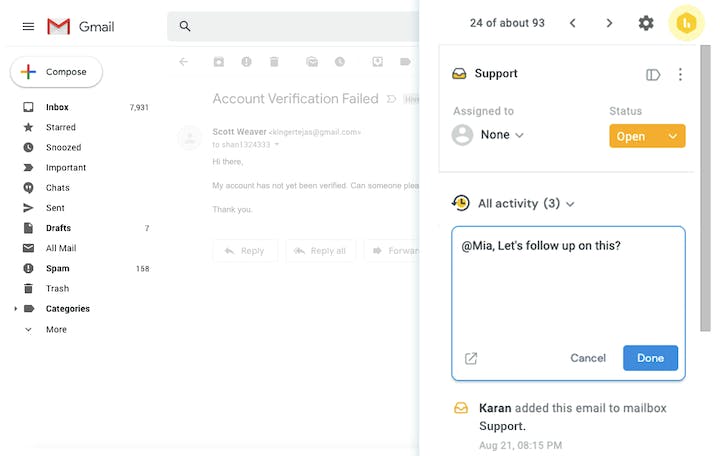
The best way to think about Hiver is as an extension to your Gmail account. With it you’re able to do things like leave internal notes on conversations and even assign conversations to specific agents.
Hiver also gives you access to other help desk features like reporting, a knowledge base, integrations, customer satisfaction (CSAT) surveys, and automation tools. However, some of these basic features are only included in their higher-cost plans.
Price: Free trial available. Plans start at $15/user per month.
4. Freshdesk
Best support software for call center support.

Freshdesk is a multi-use help desk that’s good for larger teams, especially those in a call center setting.
When you sign up, you get access to tools like a shared inbox, a knowledge base tool, and chat capabilities for managing support requests. You also get an allowance of incoming minutes to handle customer phone calls (the amount of minutes varies based on the specific plan you choose).
You also get access to some third-party integrations to keep your support tech stack connected. Though powerful, Freshdesk’s pricing/plans do get a little confusing as there are a number of optional add-ons. Also, the features we mention above are only available on their higher-tier omnichannel plans.
Price: Free trial and plan available. Paid plans start at $15/agent per month.
5. Jira Service Management
Best ticket management system for IT teams.
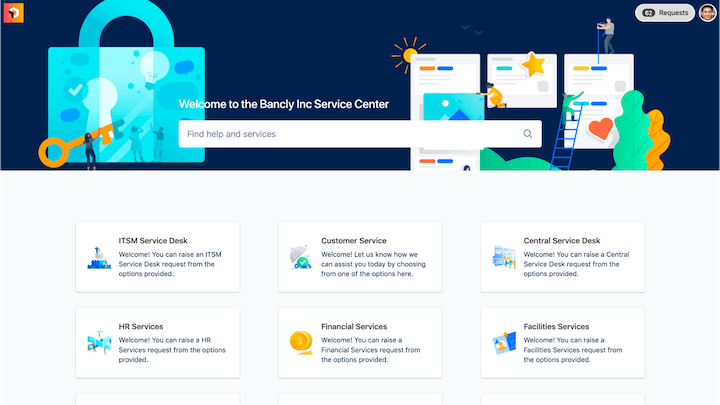
Jira Service Management is generally associated with engineering and technical teams due to its relation to Atlassian’s more widely known Jira project management tool.
The platform is a great ITSM solution that lets your team tackle request, change, incident, problem, asset, configuration, and knowledge management all in one place. It allows you to build out self-service portals for end-users and has collaboration features like a shared inbox for managing email and chat requests. Combined with custom workflows, AI tools, and reporting capabilities, the platform makes responding to user requests a simple and efficient process.
Price: Free plan available. Paid plans start at $21/agent per month.
6. Zendesk
Best help desk software for enterprise teams.
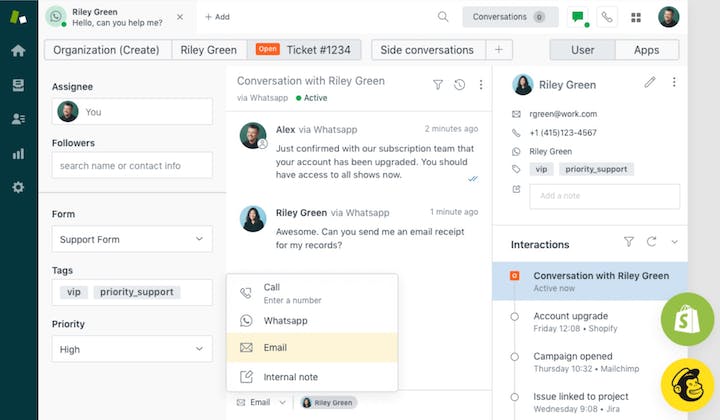
Almost anyone working in customer support has heard of Zendesk. They make a multi-channel support solution that includes features like a shared inbox, a knowledge base, and live chat tools.
Along with those, they also offer some more advanced AI-based solutions for chatbots and autoresponders (though those are only included on their higher-cost plans).
You also get access to a host of productivity and automation features, as well as over 1,000+ integrations to connect with other tools in your support ecosystem. To be honest, there’s not a lot Zendesk doesn’t do or many communication channels it doesn't cover.
However, the flip side is that it’s a very complex and complicated product that requires a lot of time, energy, and resources to get up and running.
This adds substantial additional costs on top of the monthly rate, and since most teams don’t need access to all the features Zendesk offers (do you really need to run those community forums?), it’s very possible they could find a solution with what they need for less money.
Price: Free trial available. Plans start at $19/agent per month.
7. Zoho Desk
Best help desk software for sales-focused teams.

You may be familiar with Zoho as a customer relationship management tool, but they also make a support solution for customer interactions.
Zoho Desk includes a lot of the usual suspects like a shared inbox and a knowledge base tool. They also have more advanced offerings like AI-assisted response and advanced automations for things like conversation sorting and tagging.
If you’re currently using other Zoho products, like the CRM tool, Zoho Desk integrates seamlessly with them. However, their more advanced features, and even some basic ones like live chat, are only offered on their highest-cost enterprise plan, which could be over budget for some teams.
Price: Free trial available. Plans start at $14/user per month.
8. Front
Best shared inbox software for group email collaboration.

When communicating with customers, most teams opt to use a group email address (e.g., support@yourdomain.com) to accept support customer tickets. However, some teams prefer to communicate from personal email addresses but still want the functionality of help desk software. Front lets you do just that.
With Front you can connect email, SMS, and social media accounts to a shared inbox. It also includes productivity features like internal notes as well as some automation features to reduce manual work. They also offer some analytics, though it's only offered on their higher-cost plans.
We should also note that Front doesn’t currently include a native knowledge base for FAQs or a live chat tool for real-time support like a number of the other options on our list.
Price: Free trial available. Plans start at $19/seat per month. Two seat minimum required.
9. Gorgias
Best help desk support system for low-volume support teams.
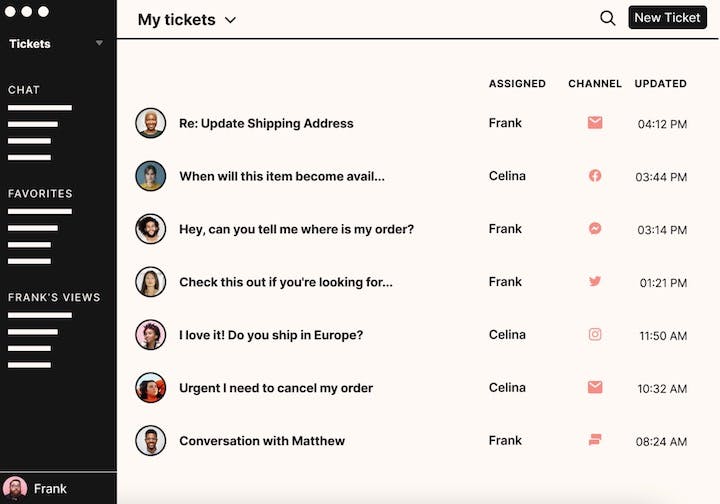
Gorgias is a help desk solution mainly focused on ecommerce. Gorgias offers access to standard features like a shared inbox tool, knowledge base tool, and live chat tool. The main differentiator from other options on the list are its Shopify, Magento, and BigCommerce integrations (although the Magento integration is only offered on the higher-tier plans).
Through those integrations, you’re able to see order details, edit orders, and even do refunds directly from your help desk, which can save a lot of time and hassle for your team. However, one major drawback is that all of their plans have ticket limits, meaning your costs could vary month over month depending on volume.
To give an idea, their Basic plan includes 300 monthly support tickets, which equals out to around 10 tickets a day — a number most teams would far exceed. From there, you’re charged an additional $40 per 100 tickets.
Price: Free trial available. Plans start at $10 per month for 50 tickets.
10. Kustomer
Best help desk management tool for project management functionality.
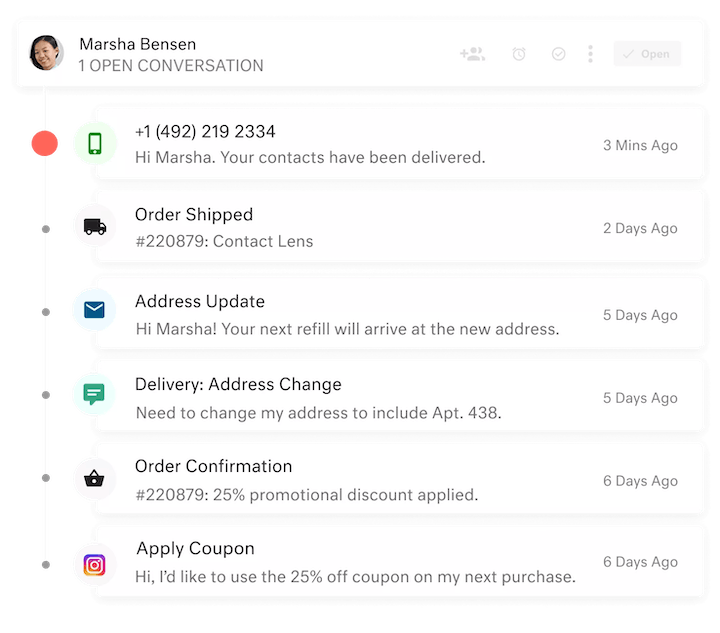
Kustomer combines help desk and project management software to create a unique type of solution. Kustomer offers multi-channel support for email, chat, phone, and social accounts. On the project management front, you can create, assign, and set due dates for tasks.
You’re also able to see a complete picture of each customer and update multiple systems at once, saving time and energy. Though Kustomer offers some impressive features, it is quite expensive, and the pricing is somewhat confusing as there are a number of tools that are add-ons.
If you want to see how Kustomer fares against the competition, take a look at our guide on the best Kustomer alternatives in the market.
Price: Plans start at $89/user per month. Eight seat minimum required.
The best free help desks
If you have inescapable budget constraints or just don't have enough support volume at the moment to justify paying for a dedicated support tool, the two free help desk software platforms below might be a good fit for your team.
11. Spiceworks
Best free help desk for IT support firms managing multiple clients.
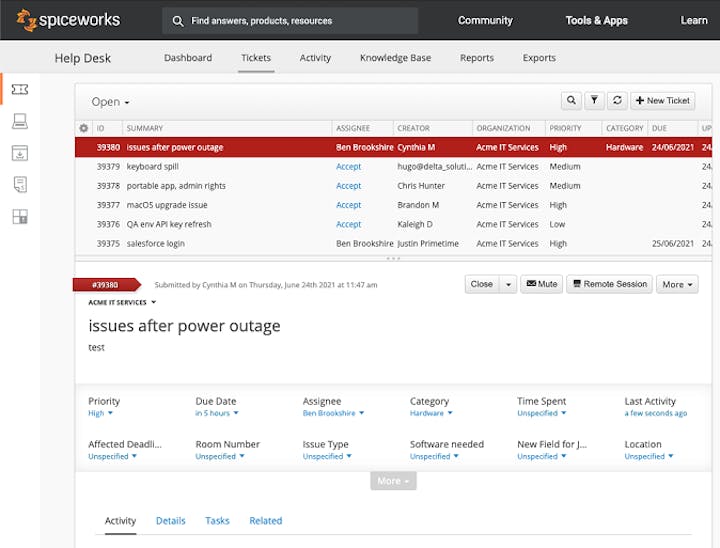
Spiceworks is another solution that helps you to build an IT help desk. With it you can easily organize and manage conversations as well as set up a self-service portal to empower people to get answers and solutions on their own.
You’re also able to automate a number of manual tasks to free up time for your IT professionals. If you’re an organization providing IT services to a number of clients, you’re able to create individual sites and user portals for each. Best of all, Spiceworks is completely free.
Price: Free.
12. Solarwinds Service Desk
Best free help desk for IT support teams.
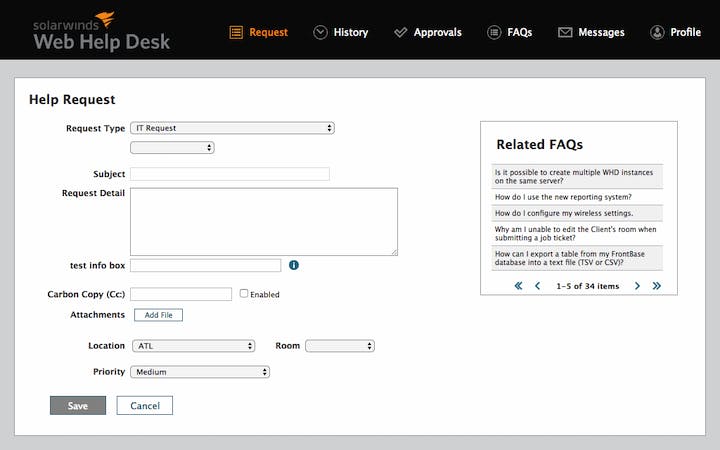
If you need a tool to help you better manage IT-related requests, then Solarwinds Service Desk could be the right option for you. With Solarwinds Service Desk you’re able to create an online form where people can submit service-related requests.
You’re also able to create a self-service portal and automate some ticket routing to reduce manual work for your staff. Finally, you get Active Directory and LDAP authentication tools.
You are limited to just one technician login, but there aren’t any contracts to sign or time limits you have to meet before upgrading to a paid account.
Price: Free plan and trial available. Paid plans start at $410; contact Solarwinds for a quote.
Why do businesses need help desk software?
While it’s definitely possible for businesses to manage support or IT requests through email platforms like Gmail or Outlook — most companies start out this way — it doesn’t scale. Email is difficult to manage when your request or employee volume starts to grow, and these systems also lack reporting capabilities which make it hard to quantify service efforts and report back to the greater company.
Help desks ease these burdens by providing:
Transparency: Help desk features like ticket assignments, statuses, and views help create a clear picture of what is going on within the service organization at any point in time. This makes it easier to balance workloads and understand where additional support may be needed.
Easier collaboration: Working out of the same email inbox (or even a collaborative one) can be confusing. There’s not a good way to split responsibilities, work together on tough issues, or keep service consistent. Help desks offer email templates, internal notes, and collision detection features that take the guesswork out of providing service as a team.
Better organization: Email clients come with labeling and search functionalities, but help desks can go further. You can merge related conversations and tag them by issue or importance. You can also integrate with other systems in your tech stack to link specific conversations to other projects the business may be working on.
Increased efficiency: While there is some automation available in email clients, help desk systems typically come with workflows that let you automate busy work. AI features are also being introduced to help service teams work smarter.
Reporting: Most help desk platforms come with out-of-the-box reporting functionality, making it easier to measure your team’s efforts. This allows you to make data-driven decisions and report service efforts back out to the rest of the company.
Security: Sharing passwords amongst multiple people is a big safety risk. Help desks allow everyone on a team to have their own login information, helping keep your customer and user data secure.
What are the different categories of help desk software?
There are multiple ways you can categorize help desk software. For example, you could break it down by software type, in which case there are three major categories:
Cloud-based: A cloud-based help desk, otherwise known as a web help desk or a SaaS-based help desk, is proprietary software hosted online through a vendor’s site or an application. In order to access the tool, you log in to the site or application and generally pay a monthly or yearly fee.
Self-hosted: Sometimes referred to as an on-premise help desk, this is when the software is installed directly onto your own servers. It could be something you build yourself or purchase from another company. Similar to cloud-based, it is also proprietary software.
Open source: Open source help desk software lets developers access the source code of a program directly, giving them the ability to customize the software in whatever way they see fit. This software is generally non-proprietary, meaning there’s no single owner of the program.
Though the above may come into play when making a purchasing decision, if you’re buying an external solution, 99% of the time it’ll be cloud-based.
Another — and possibly more useful — way to think about help desk software categorization is in relation to who you’re using the software to serve. In that case, there are two categories: internal and customer-facing.
Internal: An internal help desk solution is generally used to manage IT-related issues. Employees can log tickets directly with your IT team, making it easier to manage and organize those requests. Human resource (HR) departments may also use an internal help desk to manage requests surrounding benefits or employment issues.
Customer-facing: Customer-facing help desk software is generally used by customer support teams to manage incoming customer conversations. These tools range in functionality, but most include things like a shared inbox and some form of collaboration, productivity, and reporting tools.
The final way you might categorize software is by the size of your business:
Enterprise: These are large corporations that consist of 1000+ employees. These companies need the ability to build customized and often complex support solutions that integrate across the many software platforms used by their organization and have the resources to maintain these setups in-house.
Small and midsize businesses (SMBs): These are companies that range from <100 (small) to 999 (mid) employees. SMBs are often looking to offer multiple support channels (email, live chat, social, messaging, self-service), and benefit from out-of-the-box collaboration, reporting, automation, and integration capabilities.
Startup: Though the terms are often used interchangeably, a startup is different from a small business in that it is a company that is focused on rapid growth. Given that employee count, resources, request volume, and budget may fluctuate, startup help desk solutions need to be flexible, cost-conscious, and have the ability to scale with business needs.
Sole-proprietor or single-person LLC: Businesses that are run by a single person are different from all of the above in that they don’t need to focus on collaboration. These businesses may instead focus on features that allow them to manage multiple communication channels from a single interface.
What help desk software features are important to look for?
Depending on your specific use case, some features will be more important than others. That said, whether you’re using a help desk for internal or external conversations, there are a few key features to look for.
Easy-to-use interface
Any new software takes time to learn. However, some tools have much shorter learning curves than others. The quicker you’re able to train agents, the quicker they’re able to get back to doing what they do best: supporting others.
You should also see what the experience is like from the submitter side. Submit a request and do a few back-and-forth interactions to really get a grasp on what it’s like to use the tool from both sides of the conversation.
Reporting and metrics
Though not every part of what makes a great customer experience can be quantified, there are plenty of things that can be. With access to reporting and metrics tools, you’re better able to understand which areas you excel in and where you still have room for improvement.
Collaboration and productivity tools
Two of the biggest benefits of using a help desk tool are the capabilities to collaborate with others and to streamline work. Access to those tools helps reduce the burden on agents, giving them more time to focus on the people they’re supporting.
For example, with Help Scout, you can manage multi-channel support requests as a team via a shared inbox, add more context to a conversation with private notes, reduce duplicate work with collision detection, and give lightning-fast responses to common questions using saved replies.
You should also keep an eye out for workflow features that help you automate manual tasks like assigning and sorting incoming requests and AI tools that can help you address customer or employee needs more quickly.
Supercharge your support with AI
At Help Scout, we’ve made using AI feel effortless. Learn more about how our AI features can save you time and energy on every conversation.
Learn More
Self-service features
Look for help desk platforms that help customers and end-users find answers on their own. This can be done through a knowledge base solution where answers to FAQs and other important information can be published.
Alternatively, some businesses may want to include chatbots as part of their support strategy. When done well, support chatbots can help with answering simple questions like providing order updates and giving a status update on an outstanding ticket or request.
Scalability
Whether you're looking to purchase help desk software for your school or your company, one thing is certain: As your team continues to grow and change, so will your needs. Since switching help desks is a big undertaking, finding a solution that can grow with you is important.
It’s best to look for a tool that will work well for at least the next 18-24 months. Anything less than that and you might be setting yourself up for a future headache. Anything beyond that timeframe gets pretty hard to reliably predict.
Quality customer support
No matter how user-friendly a tool is, chances are you’ll have questions about it at some point. Though you may assume people making help desk software would be very helpful, that’s not always the case.
Once you have a list of serious contenders, take a look at each of their knowledge bases to see how comprehensive their content is and how easy it is to navigate. You should also send a few requests to their support team to see how quickly they respond and how helpful they are in your interactions overall.
How to choose the help desk that's right for your company
The help desk you choose can't deliver great customer service for you, but it is a critical early step in setting up customer support at your company. The right help desk will help your team consistently create the quality of customer service you want to provide.
To find the best help desk software for you, start by answering questions about your customers, your team, and your company.
Define “great customer service” for your company
When you’re deep into help desk comparison shopping, it’s easy to forget why you’re picking a help desk at all. You don't need to find the “best help desk software” because there is no best choice for everyone. The right help desk for you is the one that allows your team to serve your customers most effectively and consistently.
To figure that out, you need to understand the type and quality of customer support and service you want to offer. Here are some questions to help you understand.
What type of support do your customers expect? Your particular customer base will come to you with their own requirements. Do they prefer email? Are they comfortable using self-service tools? Do they expect an answer within an hour or within a day? Look for clues as to what your customers expect from you and how satisfied they are currently.
What experience do you want to offer your customers? Imagine the ideal customer support interaction from your customer’s perspective. Do they need to use a website to get help, or can they fire off a quick email? Can they choose to contact support via multiple channels? Can they answer their own questions easily using self-service tools?
What experience do you want to offer your support team? “Peanuts” creator Charles Schulz loved his favorite pen so much that he bought the entire stock when it was discontinued. While your support team may never have the same love for help desk software, they will use it constantly and rely on it heavily.
Foundations of Great Service
Discover the tools and techniques used by high-performing customer service organizations in our free, six-part video course.
Sign up for free
Determine what needs to change about your current support
Whether you’re moving from a shared Gmail mailbox or you’re switching from one help desk tool to another, this change is an opportunity to rethink your customer support approach.
Look at your existing customer service activities and consider the following:
Is this still the best way to solve this issue?
Is this approach essential to our customer experience, or could we get the same result another way?
What is our team capable of now that we weren’t capable of the last time we thought about our tools?
Once you sketch out a clear picture of the customer service you want to offer, you have a goal to measure help desk features against. Whatever help desk software you choose, it needs to help you deliver the type of service you have outlined.
Select your essential help desk features
Now it’s time to go one step further and create your list of essential features and “nice to have” features.
Help desk software that has all of your essential features beats a service desk tool that implements more “nice to haves” but misses a key requirement:
Essential help desk features: If the help desk does not do X, then we cannot create the customer service experience we want to provide.
Non-essential help desk features: If the help desk does X, we could potentially make use of it to improve the customer experience.
Work to keep that first list as short as possible. Features that sound good on a list but are poorly implemented or rarely used inhibit good service by frustrating your support team.
Now you can exclude from consideration any products that don’t cover all of your required features (either directly or by tight integration). The next step is to create an evaluation team to test your shortlisted help desks.
Create a help desk software evaluation team
If you’re just starting out or at a very small company, the evaluation team may be just you. If you have a larger team, we recommend the following mix:
One junior level customer service person.
A couple of help desk power users.
A manager or senior leader.
Combining their different needs and backgrounds will give you a more effective way to tell if the help desk really will be a good fit for your whole organization. We also recommend you get the whole evaluation team looking at the same tool at the same time, rather than each person reviewing a different option.
When you're ready to dig in and deeply evaluate your help desk options, move on to the next few steps.
Test the customer experience of each help desk solution
How will your customers interact with the help desk you choose? Use some of your typical customer questions as examples, and complete a support conversation from the customer perspective.
What will the customer see? How easy is the process for them? (Help Scout, for example, has no customer-facing portal or ticket numbers, so your customer only receives personal emails.)
Consider the experience you want to create for your customers, and test that against each tool.
Trial the help desk user experience
Your customer service team will be using this tool all day, every day. How easy is it for them to navigate around, how fast does it load, and how quickly can they find answers?
The help desk software you choose should, as much as possible, be frictionless for your team, allowing them to use all their energy helping customers and not fighting their tools.
Consider scalability
Will this solution continue to work as your business grows? Ask the sales and success teams of the solutions you are considering for an estimate of their bigger customers’ support volume.
You don’t want to pay the higher fees and complexity of software you don't need, but you also don’t want to have to pick a new help desk 12 months from now.
Review reporting options
Testing reporting is tricky when you don’t have real data to report. Demonstration accounts can give you a sense of what is possible. If you’ve thought carefully about which customer service metrics you use and why, talk to the help desk provider about how they can help you get those results with their tool.
Prioritize reliability and support
Who supports the support team? When your help desk system has an outage, when a feature is confusing, or when a process needs reworking, how will you get help? You’ll want to know which support channels are available, how quickly you’ll be helped, and how competent the team is that is helping you.
Every software product experiences issues, but some companies do much better than others in handling those situations. Submit sample requests to each help desk support team, and see how timely, useful, and friendly the responses are.
As well as your own trial experience, you can make use of external reviews and opinions to inform your choice. Customer service communities such as Support Driven are full of people who use help desk tools every day, and they are happy to share their experiences.
Make a plan for switching help desks
When you’ve made your choice of help desk and are ready to make a move, you can save your future self a bunch of trouble by making a plan.
Here are a few questions to consider:
Do you have contact forms that need to be updated?
Will your knowledge base be moving to a new tool, too?
Do you need to recreate (or rethink) workflows and automated filters in the new tool?
How will you train your team on the new tool?
Are there integrations to move or reconnect?
Buyer’s Guide to Choosing the Right Customer Support Tool
Tailored to help you identify your customer support needs, this guide will help you find the right solution, simplify your purchase decision, and get leadership buy-in.
Get the guide
Best practices for implementing a help desk software solution
When it comes to finding a help desk, there’s a lot to consider. While we’ve tried to provide you with lots of information and actionable tips within this post, Help Scout’s blog has even more information that can help you come to the right decision for your team.
Finding the right help desk software for your team
Help desk channels: Information on email, live chat, social media, and self-service
Live Chat Support 101: Definition, Benefits, and Best Practices
How a Shared Inbox Can Improve Efficiency, Transparency, and Collaboration
Guides for switching help desks
How to switch to Help Scout
Hiring and training: Information on building your support team
Delivering great customer service
Choosing your perfect help desk
Moving to a new help desk is a huge investment in your customer service team, your customers, and — ultimately — your company. A long feature list is nice to have, but you should make your choice with a broader framework in mind.
Remember, the cost of picking a tool that works for your team (and your customers) is high, so use this guide and take the time to make an informed decision.
Did you know that we also have this guide available in German?
Additional content for this post was written by Alexa Ahrens and other members of the Help Scout team.













